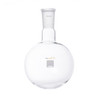
Helios
Short Path - Receiving Flask 500ml 24/40
The Short Path Receiving Flask 500ml 24/40 is a laboratory glassware item typically used in distillation processes, especially in short path distillation setups. Here's a detailed description:
-
Volume: 500ml (milliliters), indicating the capacity of the flask.
-
Neck size: 24/40, which refers to the standard joint size used in laboratory glassware for attaching various components like condensers, distillation heads, or thermometers. The "24" refers to the outer diameter of the joint (24mm), and the "40" refers to the inner diameter (40mm).
-
Material: Typically made from borosilicate glass, which is heat-resistant and durable, making it ideal for high-temperature experiments.
-
Shape: The flask generally has a flat bottom and a narrow neck. It is designed for receiving distillates during a distillation process, especially when using a short path setup, where distillation takes place over a shorter route compared to traditional distillation techniques.
-
Applications: Commonly used in chemistry labs for collecting distillates in processes like solvent distillation, essential oil extraction, and other organic chemistry applications.
This flask’s design and size make it suitable for controlled distillation, where a precise and efficient collection of distillates is essential.

Short Path - Receiving Flask 500ml 24/40
The Short Path Receiving Flask 500ml 24/40 is a laboratory glassware item typically used in distillation processes, especially in short path distillation setups. Here's a detailed description:
-
Volume: 500ml (milliliters), indicating the capacity of the flask.
-
Neck size: 24/40, which refers to the standard joint size used in laboratory glassware for attaching various components like condensers, distillation heads, or thermometers. The "24" refers to the outer diameter of the joint (24mm), and the "40" refers to the inner diameter (40mm).
-
Material: Typically made from borosilicate glass, which is heat-resistant and durable, making it ideal for high-temperature experiments.
-
Shape: The flask generally has a flat bottom and a narrow neck. It is designed for receiving distillates during a distillation process, especially when using a short path setup, where distillation takes place over a shorter route compared to traditional distillation techniques.
-
Applications: Commonly used in chemistry labs for collecting distillates in processes like solvent distillation, essential oil extraction, and other organic chemistry applications.
This flask’s design and size make it suitable for controlled distillation, where a precise and efficient collection of distillates is essential.







